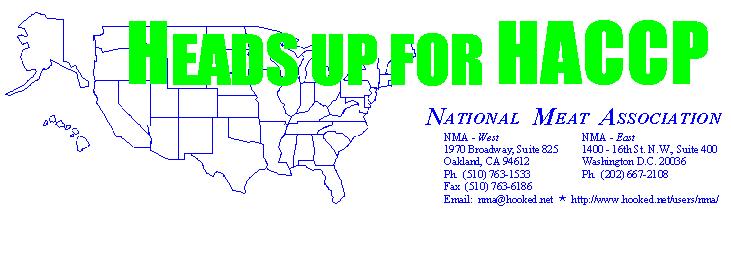

Edited by Jeremy Russell
March 16, 1998
HACCP PRINCIPLE #4: ESTABLISH MONITORING PROCEDURES
MONITORING
By Dane Bernard
, National Food Processors AssociationAccording to the National Advisory Committee on Microbiological Criteria for Foods (NACMCF) "monitoring is a planned sequence of observations or measurements to assess whether a CCP is under control." Another purpose for monitoring is to produce records that are not only useful for establishment verification but are an essential part of the verification process required by the HACCP rule. Monitoring is the act of measuring a parameter to determine that the critical limits identified at a CCP are being met. Examples of monitoring activities may include: visual observations and measurement of temperature, time, pH, and moisture level.
Monitoring and the records that are produced also provide establishments with a tool to track changes that may show a trend toward loss of process control at a CCP. If a trend is detected that indicates we are likely to experience a deviation from the established critical limits, then action can be taken to correct the situation before a deviation occurs. Monitoring is also essential to detect any deviations that may occur. In the case of HACCP, the term deviation refers specifically to not meeting a critical limit. When a deviation occurs, an appropriate corrective action must be taken. Monitoring systems should be designed to determine when such deviations occur and to alert operators so that appropriate corrective actions can be instituted. In order for HACCP to be a truly preventive system, monitoring must be conducted with sufficient frequency to detect if potentially hazardous foods may have been produced and prevent them from reaching consumers.
Monitoring procedures must also be effective. Ideally, monitoring should be automatic and continuous. This is possible with many types of physical and chemical measurements. For example, the temperature and time for the scheduled thermal process of low-acid canned foods is recorded continuously on temperature recording charts. If the temperature falls below the scheduled temperature or the time is insufficient, as recorded on the chart, the product from the retort is retained and the disposition determined based on an assessment of the safety of the product. Likewise, Ph measurement may be performed continually in fluids or by testing each batch before processing. There are many ways to monitor critical limits on a continuous or batch basis and record the data on charts. Continuous monitoring is always preferred when feasible. When it is not possible to monitor a CCP on a continuous basis, you must establish a monitoring frequency and procedure that will be reliable enough to indicate that the CCP is under control. Statistically designed data collection or sampling systems may be needed.
Accuracy of measuring instruments must also be adequate for the needs of the particular HACCP plan. Remember that critical limits are minimum values, not averages. If we specify that a product must be cooked to a minimum internal temperature of 160�F, this does not mean 159.5�F. Thus when we select monitoring equipment, make certain that it provides enough accuracy for the purpose intended. Most dial thermometers have a margin of error that makes them unacceptable for precise monitoring of critical limits. In addition, monitoring equipment must be carefully calibrated for accuracy (this is typically considered part of verification).
Assignment of the responsibility for monitoring activities is necessary for each CCP. Many establishments have found that operations staff (e.g. line supervisors, or selected line workers) should be assigned to monitor CCPs and record the results. However, for monitoring those procedures that require analysis and testing, quality control personnel are more appropriate. In any case, the HACCP regulation requires that the responsible position (job title) be identified for each monitoring task and that the frequency that the monitoring will be done is specified in the plan. The person doing the monitoring must also sign the records. Remember that if the plan says a monitoring activity will be conducted every two hours, conducting the task at three hours is a violation of the HACCP plan.
Individuals conducting the monitoring tasks should be trained in the monitoring technique that they are responsible for. Educating this person so that they fully understand the purpose and importance of monitoring, is needed so that monitoring and reporting will be done accurately and in an unbiased way. The individual should be trained to report unusual occurrences immediately so that adjustments can be made and the process will remain under control. The person responsible for monitoring must also immediately report a process or product that does not meet critical limits.